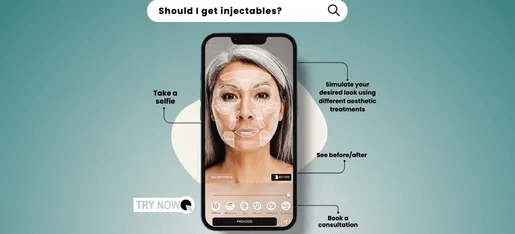Boost Energy and Focus with Men’s Hormone Therapy

Feeling tired and unfocused? Learn how men’s hormone therapy at Newest Beginnings can restore energy, boost focus, and improve overall wellness. It’s not your imagination—if you’ve been feeling more tired, unfocused, or irritable lately, there might be a biological reason behind it. Many men over the age of 30 begin to experience a gradual decline in testosterone levels. This hormonal shift can quietly impact your energy, mental clarity, mood, and overall well-being. At Newest Beginnings, we offer personalized hormone therapy for men designed to help restore balance, boost vitality, and bring you back to your best self. What Is Hormone Therapy? Hormone therapy—specifically Testosterone Replacement Therapy (TRT)—involves supplementing the body with bio-identical or synthetic testosterone to restore healthy levels. Our wellness professionals monitor this treatment closely to ensure safety, effectiveness, and optimal results. Common Signs of Low Testosterone Low testosterone (also known as Low T) affects millions of men and often goes unnoticed because the symptoms develop slowly. Signs include: Chronic fatigue, even after a full night’s sleep Brain fog or difficulty concentrating Decreased motivation or confidence Low libido or sexual performance issues Increased body fat and loss of muscle mass Irritability or mood swings If any of these symptoms sound familiar, you’re not alone and don’t have to accept them as part of aging. How Hormone Therapy Can Help Hormone therapy can have a powerful effect on your body and mind. Benefits may include: 1. Improved Energy Levels With balanced hormone levels, your body can return to its natural rhythm, helping you wake up feeling refreshed and stay energized throughout the day. 2. Sharpened Mental Focus Many men report a noticeable improvement in concentration and memory. Tasks that once felt overwhelming become manageable again. 3. Better Mood and Motivation Balanced testosterone can support emotional stability, improve mood, and reduce feelings of depression or anxiety. 4. Physical Rejuvenation You may also see an increase in lean muscle mass, improved metabolism, and better results from exercise. 5. Restored Confidence With higher energy, better mental clarity, and physical improvements, many men feel like themselves again—or better. Why Choose Newest Beginnings? Our approach is personalized, not one-size-fits-all. At Newest Beginnings, we begin with a comprehensive evaluation of your hormone levels, medical history, and lifestyle. From there, we create a treatment plan tailored specifically for your needs, with regular check-ins and support every step of the way. Start Your Journey Today If you’ve been feeling off and can’t quite figure out why, hormone therapy may be the missing link. Schedule a free consultation with our wellness experts and take the first step toward renewed energy, clarity, and confidence. Book your appointment today at https://newestbeginnings.com or call us directly to speak with our team.
Boosting Confidence with Aesthetic Enhancements: Why Self-Care Matters

Boosting Confidence with Aesthetic Enhancements: Why Self-Care Matters Introduction Confidence—it’s that magical quality that makes you feel unstoppable, whether you’re walking into a meeting, attending a social gathering, or just going about your day. But let’s face it, sometimes we all need a little extra help to feel our best. That’s where self-care and aesthetic enhancements come into play. In this article, we’ll explore how these tools can help you boost your self-esteem and why self-care is a vital aspect of holistic wellness. Understanding Confidence Confidence is more than just feeling good; it’s a state of mind that influences every area of your life. But where does it come from? Often, confidence stems from a combination of factors, including accomplishments, relationships, and, yes, your appearance. When you feel good about how you look, it’s easier to project positivity and self-assurance. The relationship between appearance and self-esteem is deeply rooted in psychology. For many, small changes in how they present themselves can lead to significant shifts in how they feel about themselves. This is where aesthetic enhancements can play a transformative role. The Role of Self-Care Think of self-care as the ultimate form of self-respect. It’s about taking time to nurture your mind, body, and soul. Self-care can be as simple as indulging in a skincare routine or as transformative as adopting a healthier lifestyle. When you prioritize self-care, you’re not just improving your outward appearance; you’re fostering inner peace and resilience. Studies show that regular self-care practices can reduce stress, improve mental clarity, and boost overall happiness. Aesthetic enhancements can be a meaningful extension of this, serving as a physical manifestation of your commitment to yourself. Aesthetic Enhancements Explained Aesthetic enhancements cover a wide range of procedures designed to enhance physical appearance. They can be broadly categorized into non-invasive treatments like chemical peels, laser therapy, and Botox, or more invasive procedures like rhinoplasty or liposuction. Non-invasive options are growing in popularity because they offer quick results with minimal downtime. These include treatments like dermal fillers to smooth wrinkles or microneedling to rejuvenate the skin. The key is choosing enhancements that align with your personal goals and comfort level. How Aesthetic Enhancements Boost Confidence Imagine looking in the mirror and finally seeing the version of yourself you’ve always envisioned. Aesthetic enhancements can help you achieve that, leading to a significant boost in self-confidence. Whether it’s fixing a minor imperfection or rejuvenating your appearance, these procedures often have a profound psychological impact. For instance, many people report feeling more assertive and energized after undergoing aesthetic treatments. This confidence often spills over into other areas of their lives, from career advancements to stronger personal relationships. It’s a domino effect: when you feel good about yourself, the world tends to respond in kind. The Connection Between Appearance and Mental Health Looking good and feeling good are intrinsically linked. Scientific studies have shown that improving physical appearance can enhance mental clarity and reduce symptoms of anxiety and depression. However, it’s essential to approach aesthetic enhancements with a healthy mindset. These treatments should be a tool to amplify your natural beauty, not a way to chase unattainable perfection.
6 Key Benefits of Vitamin Injections
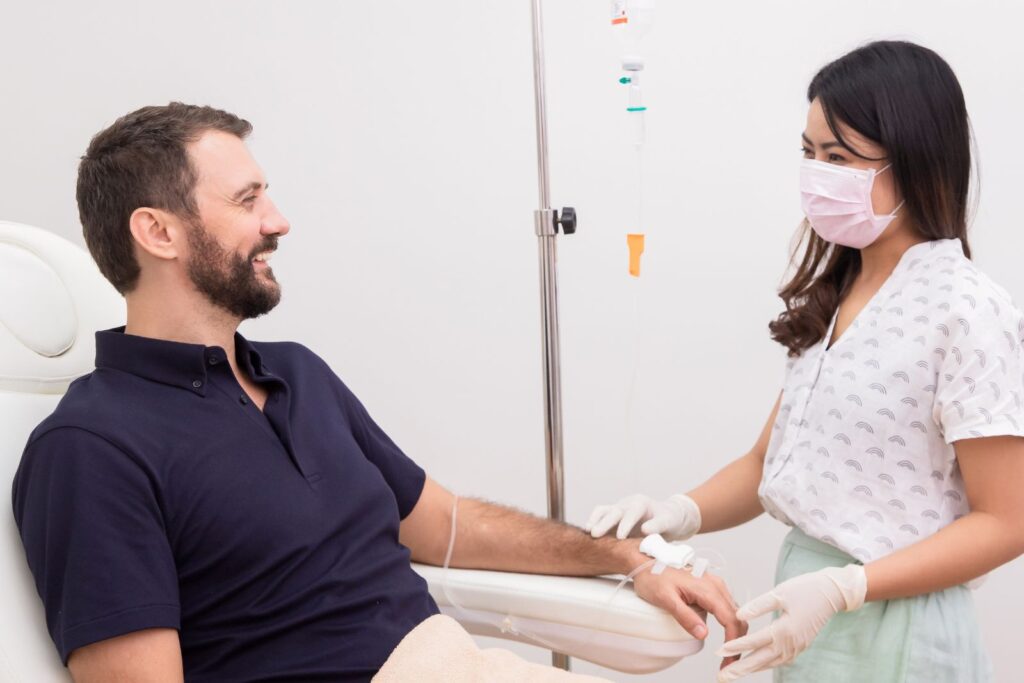
[ai_post_generator_toc] Introduction to Vitamin Injections Vitamin injections have gained popularity in recent years as a convenient and effective way to boost your overall health and well-being. These injections deliver a potent dose of essential vitamins and minerals directly into your bloodstream, bypassing the digestive system for maximum absorption and efficacy. Whether you’re looking to increase your energy levels, improve your immune function, or enhance your skin health, vitamin injections offer a range of benefits that can help you look and feel your best. Boosting Energy Levels One of the key benefits of vitamin injections is their ability to boost energy levels. By providing your body with a concentrated dose of energy-boosting vitamins like B12, vitamin C, and magnesium, these injections can help combat fatigue and increase your overall vitality. Whether you’re struggling with low energy levels due to a busy lifestyle or a nutrient deficiency, vitamin injections can provide the extra energy you need to power through your day. Improving Immune Function Another important benefit of vitamin injections is their role in improving immune function. Vitamins like vitamin C and zinc are essential for a healthy immune system, and vitamin injections can help ensure that your body has an ample supply of these nutrients to fight off infections and illnesses. By strengthening your immune system, vitamin injections can help you stay healthy and prevent common colds and flu. Enhancing Skin Health Healthy and glowing skin is often seen as a sign of good health, and vitamin injections can play a key role in enhancing your skin health. Vitamins like vitamin E and biotin are known for their skin-nourishing properties, and vitamin injections can help improve the overall appearance and texture of your skin. Whether you’re dealing with acne, dryness, or signs of aging, vitamin injections can help rejuvenate your skin and give you a radiant complexion. Supporting Weight Loss Weight loss is a common goal for many people, and vitamin injections can be a valuable tool in supporting your weight loss journey. Certain vitamins like B12 and B6 are known to boost metabolism and aid in fat breakdown, making them essential for weight management. By incorporating vitamin injections into your weight loss plan, you can enhance your metabolism, increase energy expenditure, and promote fat loss more effectively. Alleviating Nutrient Deficiencies Addressing nutrient deficiencies is crucial for maintaining optimal health, and vitamin injections can be a targeted solution for individuals with specific nutrient needs. Whether you’re lacking in vitamin D, iron, or other essential nutrients, vitamin injections can deliver a concentrated dose directly into your system to address deficiencies quickly and effectively. This can help prevent complications associated with nutrient deficiencies and promote overall well-being. Conclusion and Recommendations In conclusion, vitamin injections offer a range of benefits that can support your overall health and well-being. From boosting energy levels and improving immune function to enhancing skin health and supporting weight loss, these injections provide a convenient and effective way to ensure your body gets the essential nutrients it needs. If you’re looking to optimize your health and address specific health concerns, consider incorporating vitamin injections into your wellness routine for a targeted and efficient approach. Consult with a healthcare provider to determine the best vitamin injection regimen for your individual needs and experience the many benefits these injections can offer.
Brighten Your Look: Effective Ways to Eliminate Mustache Shadow

[ai_post_generator_toc] Introduction to Mustache Shadow Brighten Your Look: Effective Ways to Eliminate Mustache Shadow Introduction to Mustache Shadow Mustache shadow is a common concern for many individuals, especially women. It refers to the visible darkened area above the upper lip, often caused by hair follicles beneath the skin’s surface. This can be a source of self-consciousness and may impact one’s confidence. Understanding the causes of mustache shadow is crucial in finding effective solutions to eliminate it. Understanding the Causes There are several factors that contribute to the development of mustache shadow. One of the primary reasons is genetics, as some individuals have naturally darker or coarser hair in this area. Hormonal changes, such as an increase in androgen levels, can also stimulate hair growth and darken the skin. Additionally, certain hair removal methods like shaving or waxing can lead to thicker regrowth, exacerbating the appearance of the shadow. Tips for Prevention Preventing mustache shadow requires a multi-faceted approach. Firstly, choosing the right hair removal technique is essential. Consider options like laser hair removal, which can target the hair follicles and reduce regrowth over time. Additionally, using gentle exfoliation and skin brightening products can help lighten the area and prevent ingrown hairs. Effective Treatment Options When it comes to treating mustache shadow, there are various effective options available. Professional treatments like laser therapy and microdermabrasion can target the darkened skin and hair follicles, promoting a more even complexion. Topical treatments containing ingredients like hydroquinone or kojic acid can also help lighten the skin over time. Lifestyle Changes for Long-Term Results Incorporating certain lifestyle changes can further enhance the results of mustache shadow treatment. Maintaining a healthy diet rich in antioxidants and vitamins can support skin health and promote an even complexion. Protecting the skin from sun exposure with sunscreen is also crucial in preventing further darkening of the area.
Top 5 Most Popular Anti-Aging Procedures
As the pursuit of youthful skin continues to grow, many people are turning to anti-aging procedures that offer effective results with minimal downtime. Below, we explore the top five most popular treatments that have become staples in the world of aesthetic medicine. 1. Botox and Dermal Fillers: Instant Youth in a Syringe Botox and dermal fillers are among the most sought-after anti-aging treatments worldwide. Botox works by temporarily relaxing facial muscles that cause wrinkles, particularly in areas like the forehead, crow’s feet, and frown lines. This treatment smooths out existing wrinkles and prevents new ones from forming, offering a refreshed, youthful appearance. Dermal fillers, on the other hand, restore lost volume in the face, particularly in the cheeks, lips, and under-eye areas. Hyaluronic acid-based fillers are the most popular, as they not only add volume but also enhance skin hydration. The results are immediate, with little to no downtime, making these treatments a go-to for those seeking a quick rejuvenation. 2. Chemical Peels: Resurfacing for a Radiant Glow Chemical peels are a versatile anti-aging procedure that exfoliates the skin, removing dead cells and promoting the growth of new, healthy skin. Depending on the strength of the peel, it can target fine lines, wrinkles, pigmentation, and even acne scars. Mild peels, such as those using alpha-hydroxy acids (AHAs), provide a gentle exfoliation, while stronger peels with trichloroacetic acid (TCA) or phenol can penetrate deeper layers of the skin. The result is a smoother, more even-toned complexion with improved texture and firmness. 3. Laser Skin Resurfacing: Targeted Rejuvenation Laser skin resurfacing is a powerful treatment that uses concentrated beams of light to target and eliminate skin imperfections. This procedure can effectively reduce wrinkles, scars, and sun damage by stimulating collagen production deep within the skin. There are two main types of lasers used for this procedure: ablative lasers, which remove the outer layer of skin for more dramatic results, and non-ablative lasers, which work below the surface to encourage collagen growth with less downtime. Both options offer significant improvements in skin texture and tone. 4. Microneedling: Collagen Induction Therapy Microneedling, also known as collagen induction therapy, involves using a device with tiny needles to create micro-injuries in the skin. This process stimulates the body’s natural healing response, boosting collagen and elastin production. This procedure is effective for reducing fine lines, wrinkles, and scars, and it can also improve skin texture and firmness. Microneedling is often combined with other treatments, such as PRP (Platelet-Rich Plasma), for enhanced results. With minimal downtime and a relatively quick recovery, it’s a popular choice for those looking to revitalize their skin naturally. 5. Facial Contouring with Radiofrequency: Tighten and Lift Radiofrequency (RF) facial contouring is a non-invasive treatment that uses RF energy to heat the deeper layers of the skin, stimulating collagen production and tightening tissues. This treatment is ideal for those who want to lift and firm sagging skin, particularly in the jawline, neck, and cheek areas. RF treatments can be used alone or in combination with other procedures for more comprehensive rejuvenation. The results are gradual and natural-looking, with minimal discomfort and no downtime, making it a convenient option for those seeking subtle, yet effective, anti-aging solutions. Conclusion Anti-aging procedures have evolved to offer effective, minimally invasive solutions for those looking to maintain a youthful appearance. Whether you’re interested in smoothing wrinkles with Botox, resurfacing your skin with chemical peels or lasers, or tightening and lifting with RF energy, there’s an anti-aging treatment that can meet your needs. Consult with a qualified aesthetic professional to determine the best approach for your skin type and aesthetic goals. Ready to turn back the clock? Explore these top procedures and discover the possibilities of modern anti-aging treatments!
Laser Hair Removal: Your Guide to Permanent Hair Reduction
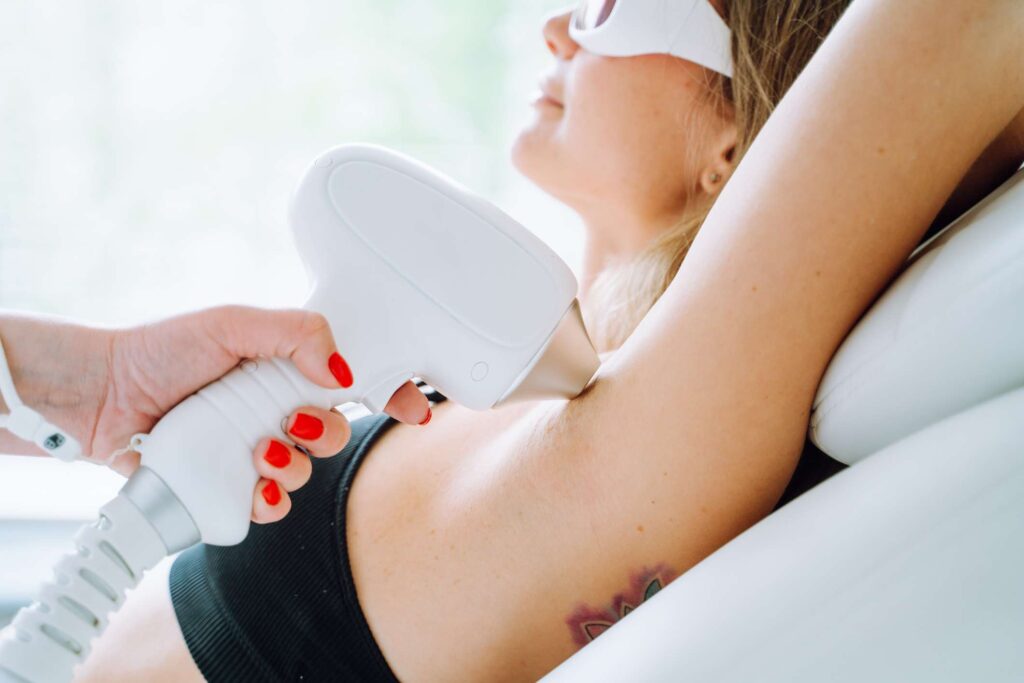
Introduction Laser hair removal has become one of the most popular methods for achieving long-lasting smooth skin. Laser hair removal offers a more permanent solution, whether you’re tired of constant shaving, dealing with painful waxing sessions, or battling ingrown hairs. In this article, we’ll delve into how laser hair removal works, what to expect during the process, and tips for ensuring the best results. How Does Laser Hair Removal Work? Laser hair removal works by targeting the pigment (melanin) in hair follicles with concentrated light beams. The hair follicle absorbs the light, which is then destroyed, inhibiting future hair growth. The process is most effective on darker hair and lighter skin tones, but technological advancements have made it accessible to a broader range of skin and hair types. What to Expect During Your First Session 1. Preparation: Shaving: You’ll be asked to shave the area to be treated a day or two before your appointment. Avoid waxing or plucking, as these methods remove the hair root, which the laser targets. Avoid Sun Exposure: Sunburnt skin cannot be treated, so it’s important to stay out of the sun or use sunscreen leading up to your session. 2. The Procedure: Sensation: Many describe the sensation during laser hair removal as a rubber band snapping against the skin. Some areas may be more sensitive, but most clients find the treatment tolerable. Duration: Depending on the size of the area being treated, sessions can last from a few minutes to an hour. 3. Aftercare: Skin Care: After treatment, your skin may feel slightly irritated or appear red. Applying a soothing cream, like aloe vera, can help. It’s also recommended to avoid sun exposure and use SPF to protect the treated area. Benefits of Laser Hair Removal Long-Term Results: Unlike shaving or waxing, which require regular upkeep, laser hair removal offers a more permanent reduction of hair growth after multiple sessions. Precision: The laser targets only the hair follicle, leaving the surrounding skin undamaged. Efficiency: Large areas like the back or legs can be treated quickly. Potential Side Effects While laser hair removal is generally safe, some people may experience temporary side effects such as redness, swelling, or minor discomfort. These effects usually subside within a few hours to a few days. Rarely, changes in skin pigmentation or scarring may occur, particularly in individuals with darker skin tones. Tips for Maximizing Results Consistency: Attend all recommended sessions, typically spaced 4-6 weeks apart, to ensure all hair follicles are treated during their growth phase. Avoid Sun Exposure: Protect your skin with sunscreen before and after treatments to prevent hyperpigmentation. Follow Aftercare Instructions: Adhering to the aftercare advice given by your technician will help prevent side effects and improve results. Conclusion Laser hair removal is a safe and effective way to achieve smoother, hair-free skin with lasting results. By understanding the process, knowing what to expect, and following proper aftercare, you can enjoy the benefits of this modern hair removal method with minimal discomfort and maximum satisfaction.
The Ultimate Guide to Chemical Peels
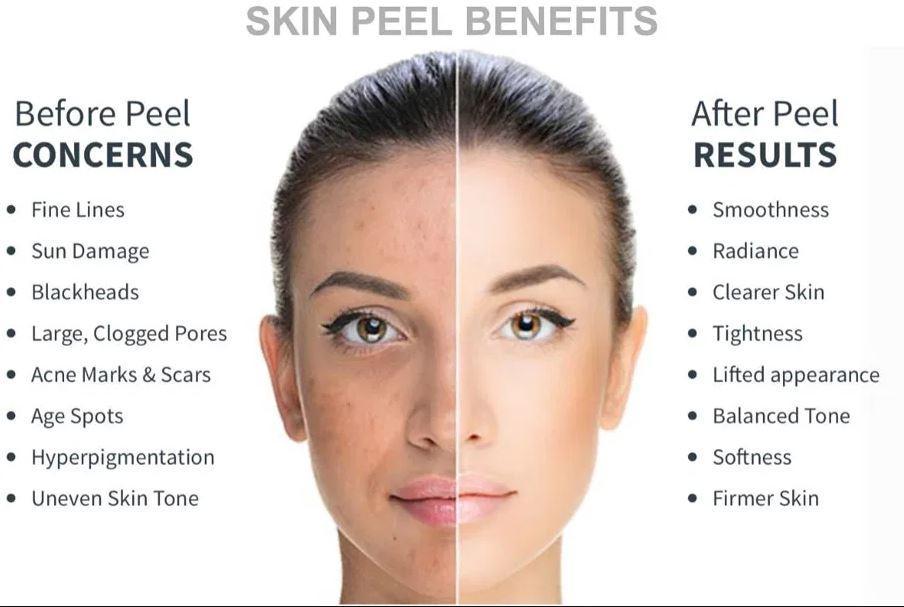
Introduction Thinking about getting a chemical peel? You’re not alone! Chemical peels have become a popular skincare treatment for their ability to rejuvenate the skin and treat various conditions. This guide will walk you through everything you need to know about chemical peels, from preparation to aftercare. What is a Chemical Peel? A chemical peel is a skin-resurfacing procedure in which a chemical solution is applied to the skin, causing it to exfoliate and eventually peel off. The new skin that replaces it is usually smoother and less wrinkled. Benefits of Chemical Peels Chemical peels offer a range of benefits, including: Skin Rejuvenation: Helps reduce the appearance of fine lines and wrinkles. Treating Skin Conditions: Effective for acne, hyperpigmentation, and uneven skin tone. Types of Chemical Peels There are three main types of chemical peels: Superficial Peels: Mild acids like alpha-hydroxy acid are used to penetrate only the outer layer of skin. Medium Peels: Glycolic or trichloroacetic acid is applied to reach the middle and outer layers of skin. Deep Peels: Trichloroacetic acid or phenol is used to penetrate the deeper layers of skin. Who Can Benefit from a Chemical Peel? Chemical peels can benefit a wide range of individuals, particularly those with: Acne scars Age spots Fine lines and wrinkles Sun-damaged skin Preparing for a Chemical Peel Preparation is key to a successful chemical peel. Here’s what you need to do: Consult a Dermatologist: Discuss your skin type and concerns to determine the best peel for you. Pre-Treatment Skincare Routine: Use gentle cleansers and avoid exfoliating products. Avoid Certain Medications: Some medications can increase sensitivity to the peel. The Chemical Peel Procedure The procedure typically involves these steps: Cleaning the Skin: The dermatologist will clean your skin thoroughly. Applying the Peel: The chemical solution is applied to your skin. Neutralizing the Peel: After a set time, the solution is neutralized and removed. The entire process usually takes about 30-60 minutes. Post-Peel Care Proper aftercare is crucial for optimal results: Immediate Aftercare: Apply soothing creams and avoid sun exposure. Long-Term Care: Use sunscreen regularly and follow a gentle skincare routine. Possible Side Effects and Risks While chemical peels are generally safe, some side effects may include: Redness Swelling Peeling Rare but serious risks can include scarring and infection. Results and What to Expect You can expect smoother, more radiant skin post-peel. The timeline for results varies: Superficial Peels: Results in a few days. Medium Peels: Results in about a week. Deep Peels: Results in two weeks or more. How Often Can You Get a Chemical Peel? The frequency of chemical peels depends on the type: Superficial Peels: Every 4-6 weeks. Medium Peels: Every 3-6 months. Deep Peels: Once every few years. Chemical Peels vs. Other Skin Treatments Chemical peels are often compared to other treatments like microdermabrasion and laser therapy. While all can improve skin texture, chemical peels are particularly effective for deeper issues like pigmentation. Frequently Asked Questions (FAQs) Here are some common questions about chemical peels: Q: How painful is a chemical peel? A: Pain levels vary; superficial peels cause mild discomfort, while deeper peels can be more painful. Q: Can I wear makeup after a chemical peel? A: It’s best to avoid makeup for at least a week after the procedure. Q: How long do the results of a chemical peel last? A: Results can last from a few months to several years, depending on the peel depth and your skincare routine. Q: Are chemical peels safe for all skin types? A: Generally, yes, but it’s crucial to consult with a dermatologist to ensure it’s appropriate for your skin type. Q: Can I do a chemical peel at home? A: While at-home peels are available, professional treatments are recommended for safety and effectiveness. Conclusion Chemical peels are a fantastic option for those looking to rejuvenate their skin and address various skin issues. By understanding the types, benefits, and necessary preparations, you can ensure a smooth and effective experience. Always consult with a professional to determine the best approach for your skin. Frequently Asked Questions (FAQs) Q: How painful is a chemical peel? A: Pain levels vary; superficial peels cause mild discomfort, while deeper peels can be more painful. Q: Can I wear makeup after a chemical peel? A: It’s best to avoid makeup for at least a week after the procedure. Q: How long do the results of a chemical peel last? A: Results can last from a few months to several years, depending on the peel depth and your skincare routine. Q: Are chemical peels safe for all skin types? A: Generally, yes, but it’s crucial to consult with a dermatologist to ensure it’s appropriate for your skin type. Q: Can I do a chemical peel at home? A: While at-home peels are available, professional treatments are recommended for safety and effectiveness.
PRF Hair Treatment: Transforming Your Hair Journey
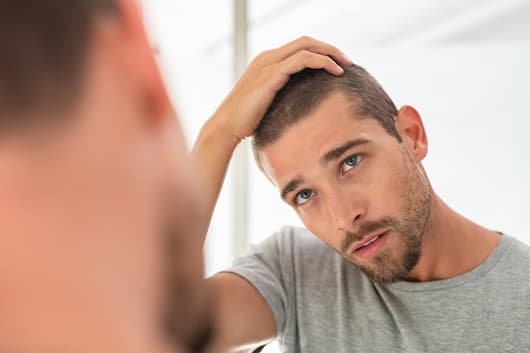
Introduction Hair loss is a common concern affecting millions of individuals worldwide, leading to a quest for effective treatments. PRF (Platelet-Rich Fibrin) hair treatment has emerged as a promising solution, offering hope to those struggling with thinning hair and baldness. This article delves into the intricacies of PRF hair treatment, exploring its benefits, procedures, and the science behind its success. We aim to provide a comprehensive guide to understanding PRF, its application, and its impact on your hair journey. What is PRF Hair Treatment? Definition of PRF (Platelet-Rich Fibrin): PRF is a concentration of platelets and fibrin derived from the patient’s own blood. It is known for its regenerative properties and is increasingly used in various medical fields, including hair restoration. Difference between PRP and PRF: While both PRP (Platelet-Rich Plasma) and PRF are used in regenerative medicine, PRF is considered superior due to its slower release of growth factors and lack of additives. This makes PRF more effective in promoting tissue healing and regeneration. History and development of PRF in hair treatment: PRF was initially used in dentistry and orthopedics for its healing properties. Over time, its application extended to aesthetic medicine, including hair restoration, thanks to its ability to stimulate hair growth and improve hair density. The Science Behind PRF Biological mechanisms of PRF: PRF works by harnessing the body’s natural healing processes. It contains high concentrations of platelets and fibrin, which release growth factors essential for tissue regeneration and healing. Role of platelets and fibrin in hair growth: Platelets are rich in growth factors that promote cell proliferation, collagen production, and angiogenesis. Fibrin acts as a scaffold, supporting the sustained release of these growth factors and enhancing their effectiveness. How PRF stimulates hair follicles: When injected into the scalp, PRF stimulates the dormant hair follicles, enhancing their growth phase. This leads to increased hair thickness and density over time. Types and Categories of Hair Loss Androgenetic alopecia: Commonly known as male or female pattern baldness, this type of hair loss is genetic and hormonal. Alopecia areata: An autoimmune disorder that causes patchy hair loss. Telogen effluvium: A temporary form of hair loss triggered by stress, illness, or hormonal changes. Traction alopecia: Hair loss caused by repetitive tension on the hair, often from tight hairstyles. Scarring alopecia: Permanent hair loss resulting from inflammatory skin conditions or physical trauma to the scalp. Symptoms and Signs of Hair Loss Common signs of hair thinning: Gradual thinning on the top of the head, receding hairline, and widening part. Patterns of baldness: Circular or patchy bald spots, diffuse thinning, and complete baldness in some areas. Early indicators to watch for: Increased hair shedding, visible scalp, and reduced hair volume. Causes and Risk Factors for Hair Loss Genetic predisposition: Family history plays a significant role in hair loss patterns. Hormonal changes: Conditions like pregnancy, menopause, and thyroid disorders can impact hair health. Environmental factors: Pollution, UV exposure, and harsh hair treatments can contribute to hair loss. Lifestyle influences: Poor diet, smoking, and excessive alcohol consumption can weaken hair follicles. Medical conditions: Diseases such as lupus, diabetes, and scalp infections can lead to hair loss. Diagnosing Hair Loss Clinical examination: A thorough scalp examination by a dermatologist or trichologist. Medical history review: Understanding the patient’s health background and potential triggers. Diagnostic tests (scalp biopsy, blood tests): To rule out underlying medical conditions and confirm the type of hair loss. Importance of early diagnosis: Early intervention can prevent further hair loss and improve treatment outcomes. PRF Hair Treatment Procedure Preparing for the treatment: Consultation with a specialist to assess suitability and set realistic expectations. Step-by-step process: Blood draw from the patient. Centrifugation to separate PRF from the blood. Injection of PRF into the scalp. Post-treatment care: Avoiding strenuous activities, protecting the scalp, and following a prescribed hair care routine. Expected outcomes and timeline: Gradual improvement in hair thickness and density, with visible results typically seen within 3-6 months. Benefits of PRF Hair Treatment Natural and non-surgical approach: Utilizes the patient’s own blood, reducing the risk of allergic reactions and infections. Enhanced hair density and volume: PRF promotes the growth of new hair and strengthens existing hair. Long-lasting results: Patients often enjoy sustained improvement in hair quality and density. Minimal side effects: Common side effects include mild swelling and redness, which usually resolve quickly. Challenges and Limitations of PRF Not suitable for all types of hair loss: PRF is most effective for androgenetic alopecia and other non-scarring types of hair loss. Variability in patient response: Individual results can vary based on the extent of hair loss and overall health. Cost considerations: PRF treatment can be expensive, and multiple sessions may be required. Preventive Measures for Hair Loss Healthy diet and nutrition: Eating a balanced diet rich in vitamins and minerals supports hair health. Stress management techniques: Practices like meditation, yoga, and regular exercise can reduce stress-related hair loss. Proper hair care routines: Using gentle hair care products and avoiding excessive heat styling. Avoiding harmful styling practices: Steering clear of tight hairstyles and chemical treatments that damage hair. Personal Stories and Case Studies Success stories of PRF treatment: Many individuals have experienced significant improvement in hair growth and density. Testimonials from patients: Positive feedback from patients highlights the effectiveness of PRF treatment. Before and after photos: Visual evidence of the transformative impact of PRF on hair health. Expert Insights Interviews with dermatologists and trichologists: Medical professionals share their insights on PRF treatment. Professional opinions on PRF efficacy: Experts discuss the benefits and potential of PRF in hair restoration. Future prospects in hair loss treatments: Innovations and advancements that could enhance the effectiveness of PRF.
Comparing Med Spas and Day Spas: Unveiling Differences
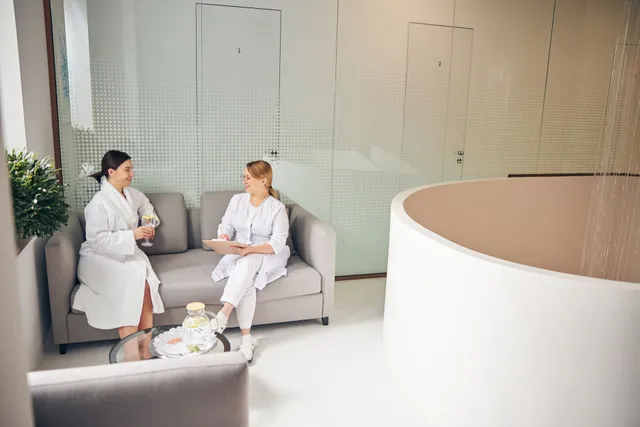
Comparing Med Spas and Day Spas: What Sets Them Apart? When it comes to pampering and self-care, spas are a go-to destination for many. However, not all spas are created equal. The two main types of spas you’ll encounter are med spas (medical spas) and day spas. While both offer a range of services designed to improve your well-being and appearance, they differ significantly in their approach and offerings. Let’s dive into the key differences between med spas and day spas. What is a Med Spa? Services Offered at a Med Spa Med spas combine the relaxing environment of a traditional spa with advanced medical treatments. These facilities offer a range of medical-grade procedures such as Botox, dermal fillers, laser treatments, and chemical peels. Med spas also often provide skin rejuvenation and anti-aging treatments, which are typically overseen by licensed healthcare professionals. Staff at a Med Spa The staff at a med spa usually includes licensed medical professionals such as doctors, nurse practitioners, and medical aestheticians. These professionals ensure that all treatments are performed safely and effectively. The presence of a medical director is common, ensuring that the procedures adhere to medical standards. Equipment and Procedures Med spas utilize advanced medical equipment to perform their treatments. This equipment is often more sophisticated and capable of delivering more invasive procedures compared to what you’d find at a day spa. The treatments at a med spa can have a longer-lasting impact on your appearance, thanks to the medical-grade products and technologies used. Purpose of a Med Spa The primary goal of a med spa is to improve your aesthetic appearance through scientifically backed treatments. In addition to cosmetic enhancements, some med spas offer wellness services like hormone therapy and weight management programs. The combination of medical expertise and spa-like relaxation provides a comprehensive approach to beauty and wellness. What is a Day Spa? Services Offered at a Day Spa Day spas focus on providing non-medical treatments designed to help you relax and rejuvenate. Common services include massages, facials, body wraps, and manicures/pedicures. These treatments are aimed at enhancing your overall well-being and providing a luxurious experience. Staff at a Day Spa The staff at a day spa consists of licensed massage therapists, aestheticians, and beauty professionals. Unlike med spas, day spas do not require medical oversight, as their treatments are non-invasive and primarily focused on relaxation and beauty. Equipment and Procedures Day spas use standard spa equipment for their treatments. The procedures are designed to be soothing and stress-relieving, utilizing products and techniques that promote relaxation and beautification without the need for medical intervention. Purpose of a Day Spa The main purpose of a day spa is to provide a serene environment where clients can unwind and escape from the stresses of everyday life. Treatments are centered around relaxation, stress relief, and beautification, making day spas ideal for a quick getaway or a special treat. Key Differences Between Med Spas and Day Spas While both med spas and day spas aim to improve your well-being, they do so in different ways: Services: Med spas offer medical-grade treatments while day spas provide non-medical, relaxation-focused services. Staff: Med spas have licensed medical professionals; day spas employ beauty and wellness practitioners without medical oversight. Equipment: Med spas use advanced medical equipment for more invasive procedures; day spas use standard spa tools for non-invasive treatments. Purpose: Med spas focus on aesthetic enhancement and medical wellness; day spas emphasize relaxation, stress relief, and beautification. Which One is Right for You? Choosing between a med spa and a day spa depends on your personal goals and needs. If you’re looking for advanced treatments to address specific aesthetic concerns, a med spa may be the right choice. On the other hand, if you seek a peaceful retreat to relax and pamper yourself, a day spa is likely the better option. In conclusion, both med spas and day spas offer unique benefits. Understanding the differences can help you make an informed decision and choose the type of spa that best suits your needs and preferences. Whether you opt for the medical expertise of a med spa or the tranquil environment of a day spa, you’re sure to enjoy a rejuvenating experience. 4o
Top Laser Hair Removal Tips for First-Time Patients

Pre-Treatment Tips 1. Choose a Reputable Clinic Research: Look for clinics with certified and experienced practitioners. Reviews: Read testimonials and reviews from previous clients. Consultation: Schedule a consultation to discuss your needs and expectations. 2. Understand Your Skin and Hair Type Suitability: Laser hair removal is most effective on light skin with dark hair, but newer technologies can treat various skin tones and hair colors. Professional Assessment: Get assessed by a professional to determine the best laser type for you. 3. Avoid Sun Exposure Tanning: Avoid sunbathing and tanning beds for at least four weeks before the treatment. Sunblock: Use a broad-spectrum sunscreen with SPF 30 or higher if sun exposure is unavoidable. 4. Stop Certain Hair Removal Methods Waxing and Plucking: Refrain from waxing, plucking, or threading the area for at least four to six weeks before your treatment. Shaving is allowed. Bleaching: Avoid bleaching the hair as the laser targets the pigment in the hair. 5. Shave Before Treatment Preparation: Shave the treatment area 24-48 hours before your appointment. This allows the laser to focus on the hair follicle beneath the skin. 6. Avoid Certain Products Skin Care: Avoid using creams, lotions, and deodorants on the day of your treatment. Your skin should be clean and free of any products. Medications: Inform your practitioner about any medications you are taking, especially photosensitizing drugs. During Treatment Tips 1. Expect Mild Discomfort Sensation: The procedure might feel like a rubber band snapping against your skin. Pain levels vary but are generally tolerable. Pain Relief: Ask about numbing creams or cooling devices that can be used to minimize discomfort. 2. Protective Gear Eye Protection: You will be given protective eyewear to shield your eyes from the laser light. Ensure it fits properly and is worn throughout the session. Post-Treatment Tips 1. Manage Side Effects Common Reactions: Redness and swelling are normal and should subside within a few hours to a couple of days. Cool Compresses: Apply ice packs or cool compresses to soothe the treated area. 2. Avoid Sun Exposure Protection: Continue to avoid direct sun exposure and use a high-SPF sunscreen to protect the treated area. Healing: Sun exposure can lead to complications like hyperpigmentation. 3. Skip Certain Activities Heat: Avoid hot showers, saunas, and strenuous exercise for 24-48 hours post-treatment to prevent irritation. Scrubbing: Do not scrub or exfoliate the treated area for a few days. 4. Follow-Up Treatments Schedule: Adhere to the recommended treatment schedule. Laser hair removal typically requires multiple sessions (usually 6-8) spaced 4-6 weeks apart. Consistency: Consistency is key to achieving optimal results. 5. Monitor Your Skin Reactions: Watch for any unusual reactions such as blisters, burns, or significant swelling. Contact your clinic immediately if these occur. 6. Moisturize Hydration: Keep the treated area moisturized to promote healing and reduce dryness or flaking. How many sessions are needed for laser hair removal? Typically, 6-8 sessions are required for optimal results, spaced 4-6 weeks apart. Is laser hair removal painful? Most patients describe the sensation as a rubber band snapping against the skin. Pain levels vary, but the discomfort is generally tolerable. Can all skin types undergo laser hair removal? While laser hair removal is most effective on light skin with dark hair, newer technologies can treat a variety of skin tones and hair colors. A professional assessment is recommended. What should I avoid before my laser hair removal session? Avoid sun exposure, tanning beds, waxing, plucking, bleaching, and using certain skin care products. Shave the treatment area 24-48 hours before the appointment. What should I do after my laser hair removal session? Avoid sun exposure, hot showers, saunas, and strenuous exercise for 24-48 hours. Apply cool compresses to reduce redness and swelling, and keep the treated area moisturized.

